 5th Edition Summer 2021
Welcome!

Happy summer to everyone! Innovation is everywhere, and we have some for you in this edition of our quarterly newsletter. We highlight success stories to encourage information exchange and motivation to think outside the box to solve problems. We are always looking for more innovation stories to share so please feel free to contact us about being featured in future editions of the newsletter. Our team continues to stay busy. We recently presented Federal Highway Administration (FHWA) Local Aid Support initiatives to the National Association for County Engineers Conference. We also participated as a speaker during the Maryland County Engineers Association meeting. We are in the process of reviewing Build a Better Mousetrap entries for 2021 and will announce the winners during the next National LTAP and TTAP Association (NLTAPA) Virtual Conference coming up July 20–22. Lastly, we encourage you to take new online training that is available on our website. Enjoy this edition and we are available to answer any questions you might have at CLAS@dot.gov.
Sincerely,
Joe Conway
Director, FHWA Local Aid Support
|
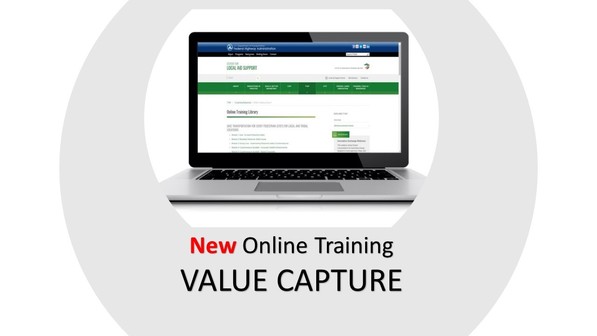 FHWA’s Local Aid Support team is excited to announce new online training. Visit our website for more information on Value Capture innovation.
In this edition:
LOCAL INNOVATION
City of Grandview, Missouri
Photo Credit: Brenda Macke, PE (Burns & McDonnell)
The city of Grandview, Missouri, is building a bridge to improved public communication through improvements to managing their stormwater. Significant flooding in 2017 prompted the city of Grandview to update its 30-year Stormwater Master Plan. To save time and money, the city called in assistance from a locally based engineering firm, Burns and McDonnell. The team, along with representatives from the TREKK Design Group, took the master plan update in a more innovative direction by developing a suite of tools to provide desktop analysis of stormwater issues using readily available data. The team created map layers in a geo-database framework, compatible on a multitude of platforms. The tools help the user identify and evaluate locations of potential drainage issues, overland flow paths and any obstructions, and drainage service requests from residents. Layering the tools paints a picture of how water moves through Grandview. “One of the challenges included understanding the limitations of the existing data available. For example, the accuracy of LiDAR and how to efficiently estimate impervious coverage using the available aerial photography,” says Brenda Macke, a project manager with Burns and McDonnell.
Developing the tools was a six-month project. The time frame was tied to defining what existing data was readily available and how data sources connected. The new tools have improved the city’s response to stormwater issues, and they also provide a visual to help the city explain the “why” to its residents. “This tool moved the city of Grandview from a static project list to a living tool that can be updated over time,” says Macke. “It also provides a reference to city staff of variables to be used in stormwater calculations on a sub-watershed level (approximately 5 acres of drainage area), eliminating some of the subjectivity related to estimating the variables.”
Another city has contacted Grandview about using a similar approach. Additionally, development of the new tools has forged new partnerships with the United States Geological Survey and the Missouri Department of Natural Resources.
For more information on the Next Generation Stormwater Tools, contact Brenda Macke, project manager (PE), at brmacke@burnsmcd.com.
Image of Grandview Stormwater Dashboard. Photo credit: Brenda Macke, PE (Burns & McDonnell)
Dickinson County, MI
CR 573 Bridge over the Sturgeon River. Built in 1945.
Source: Dickinson County Road Commission, MI
Drumming up support for using innovation on transportation projects can be difficult. But, Lance Malburg, an engineer with the Dickinson County Road Commission in Michigan, says to not give up. His efforts to push for an innovation is finally coming to life. Malburg is leading the charge to rehabilitate a county bridge that was built in 1945. The bridge over the Sturgeon River, referred to as CR 573, was built with no mechanical connection or shear studs between the deck and beams. Without the connection, the load analysis for load posting must consider the deck separate from the beams with the limiting factor being the deck. A few years back, Malburg proposed adding shear studs to make a “T” section for analysis. This would also greatly increase load capacity. Malburg says, “Calculations show that after the shear studs are installed, we can take off the load capacity warning.”
After years of promoting the use of adding shear studs to the structure to improve load capacity, the innovation finally gained traction last year when Malburg finally received funding to rehabilitate the bridge. He is hoping to start work on the bridge very soon, with completion by October. According to Malburg, “If successful, this technique can be used by many agencies to strengthen bridges built without shear studs to increase load capacity.”
For more information, contact Lance Malburg at lance@dickinsoncrc.com.
Source: Dickinson County Road Commission, MI

District of Columbia
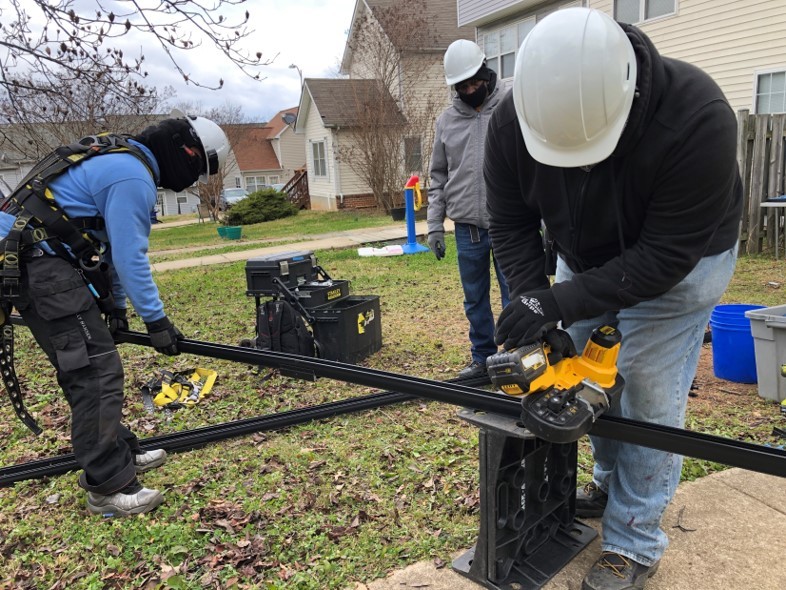 Source: District of Columbia Department of Employment Services (DOES)
A pilot Workforce Training Program at DCIA is seeing success since its launch in 2019. The program is a partnership between the District of Columbia Department of Employment Services (DOES) and the District Department of Transportation (DDOT). The purpose of the 12-month pilot was to encourage careers in transportation as street sign installers. The pilot was launched in conjunction with the city’s efforts to invest in infrastructure by improving traffic signage that was confusing or dysfunctional for residents. For this effort to be a success, the city needed to recruit more street sign installers. Six individuals joined the pilot program, where they received hands-on classroom instruction and then six weeks of on-the-job training with DDOT’s Street Sign Installation unit.
All participants completed the training program and received their certifications in Flagger and OSHA-10 Construction Safety. “They have exceeded the expectations of the DDOT and DOES Program Managers. The trainees received robust detailed hands-on training experience, that positively impacted the community,” says Aaron Sisko, senior program manager with DCIA.
The pilot trainees have been placed into various positions within the DDOT. Sisko says, “The trainees are continuing to perform critical tasks to support DDOT mission. The goal right now is to help these six individuals achieve higher within their positions and then we’ll assess the next steps for this program.”
For more information, contact Aaron Sisko at Aaron.Sisko@dc.gov.
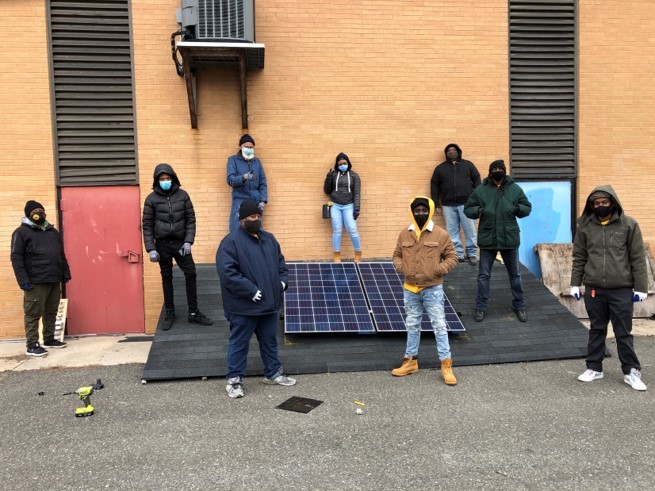 DOES Workforce Training Program participants from various program areas. Source: District DOES
Back to top
NEWS & HAPPENINGS
FHWA recently initiated the Mentoring, Assistance, Training, and Communication Help (MATCH) program to provide free, broad-based technical assistance to local and tribal agencies facing roadway safety challenges. The program connects agencies requesting assistance with volunteers that have specific expertise to help successfully address the identified challenges.
Local and tribal roads are diverse in terms of location, infrastructure, operations, and safety concerns and can benefit from learning about strategies to address safety concerns from others who have encountered and mitigated similar challenges on similar roads. All local and tribal agencies are eligible to apply for technical assistance by a mentor, but requests must be submitted directly by a public agency. Public agency transportation safety professionals who have specific expertise related to local or tribal road safety can serve as mentors.
Technical assistance through MATCH is always free. Mentoring can be provided in the form of phone calls, email exchanges, web conferences, or site visits (on a limited basis), based on the requesting agency’s needs.
Please visit https://safety.fhwa.dot.gov/local_rural/match for more information about the MATCH program and how to apply for free technical assistance, as well as how to apply to be a mentor.
Contact MATCH@dot.gov with any questions.
Back to top
 Source: FHWA
CASE STUDY SUMMARY
Contributer: Andrea Kirk, Local Aid Support Program Manager
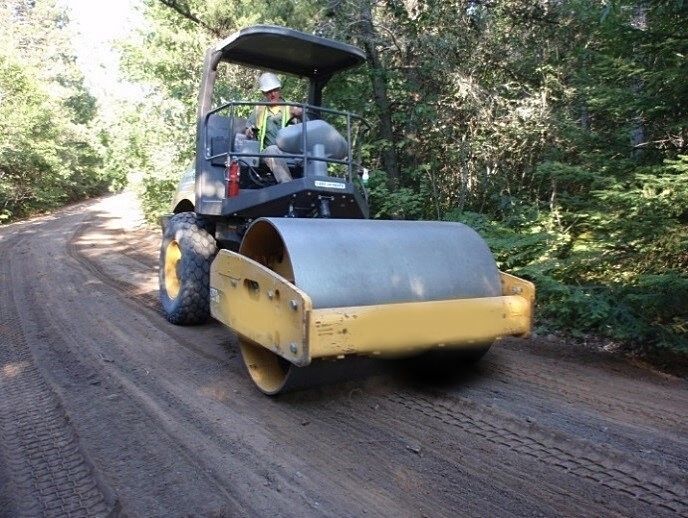 Compacting blended soil-ash mix. Source: U.S. Forestry Service
The U.S. Forest Service was looking for alternative ways to stabilize remote roads with sandy soils and was introduced to the European technique of using paper mill boiler ash. This was an attractive solution because many of the roads in question are located near the paper industry and the material is readily available. The U.S. Forest Service chose to stabilize two one-mile road segments in the Chequamegon-Nicolet National Forest, which is part of the northern Great Lakes region. The site was selected because it had unstable sand roads previously treated unsuccessfully with other stabilization materials such as chunk wood and woodchips, and there was an active paper mill nearby. The sandy composition of the roads was causing ruts and required constant grading and repair. Both roads are considered “very low-volume roads” with generally light seasonal traffic.
The U.S. Forest Service worked with the Wisconsin Dept. of Natural Resources (WDNR) to obtain permission for the application of boiler ash. No federal permits were required for the activity because paper mill byproduct is not regulated under the Resource Conservation and Recovery Act unless it contains residuals regulated in accordance with 40 CFR Part 261. Material Safety Data Sheets and periodic testing required by state conservation officials will determine if the boiler ash contains properties that define it as a hazardous waste. The boiler ash byproduct was sourced from the Flambeau Papers Mill in Park Falls, Wisconsin. The WDNR had already issued approval to Flambeau River Papers to distribute their boiler ash, but the end-user was also required to obtain clearance for the specific use. In order to use this type of material as a road stabilizer in the national forest, the U.S. Forest Service was required to obtain a state environmental clearance and permit from the WDNR.
Once the engineering properties were tested, Forest Service personnel and their contractors completed the following: conducted falling weight deflectometer (FWD) testing on the road grades at about 0.1-mile intervals; cleared vegetation, graded, and shaped the road prism; conducted dynamic cone penetrometer (DCP) testing on the cleared road grade at about 0.1-mile intervals; and tested the maximum density and optimum moisture content and California bearing ratio for the untreated road grade soils. The Wisconsin Department of Transportation conducted FWD tests on both roads in July 2015 before initial road grading. U.S. Forest Service personnel and the construction contractor’s geotechnical engineering lab (Coleman Engineering) conducted DCP testing (ASTM D 6951) after the initial road grading but before boiler ash treatment. In addition to FWD and DCP testing, the construction contractor’s geotechnical engineering lab conducted basic compaction testing using a nuclear density gauge (ASTM D 6938) as part of normal construction quality control to ensure at least 90 percent relative compaction of the ash-soil blends.
U.S. Forest Service personnel used readily available construction equipment to keep costs low. Boiler ash was delivered by end-dump trucks and was spread using a front-end loader and a motor grader. It was mixed into the soil using an agricultural disk pulled by a tractor, and water was added using a trailer mounted water tank. The blended material was compacted using a smooth-wheeled vibratory compactor. The material was blended with the upper 3 in. (7.6 cm) of soil at the following proportions:
- 3 in. (7.6 cm) thick (50%–50% ash–soil mix) on first 1/3-mi (0.5-km) road segment;
- 2 in. (5.1 cm) thick (40%–60% ash–soil mix) on second 1/3-mi (0.5-km) road segment; and
- 1 in. (2.5 cm) thick (25%–75% ash–soil mix) on last 1/3-mi (0.5-km) road segment.
When necessary, a water truck was used to adjust soil moisture content.
Visual observations and surveys showed the treatment on both roads was effective. Of the two demonstration roads, the sugar sand road, FR 685, benefited most from ash stabilization. The extreme rutting observed before treatment was virtually eliminated and the road kept its shape throughout the 1-year test period that included the full cycle of seasonal ground conditions and the seasonal (mostly summer) traffic. Surveys showed very little change (mostly less than 0.2 ft, 6 cm) in road surface elevation over the year. FR 1155, with its sandy loam subgrade, did not have the extreme rutting or traction problems that plagued FR 685. After the 1-year monitoring period, it appeared to be in same condition as it was after the initial clearing and shaping, and cross sections showed the road held its shape.
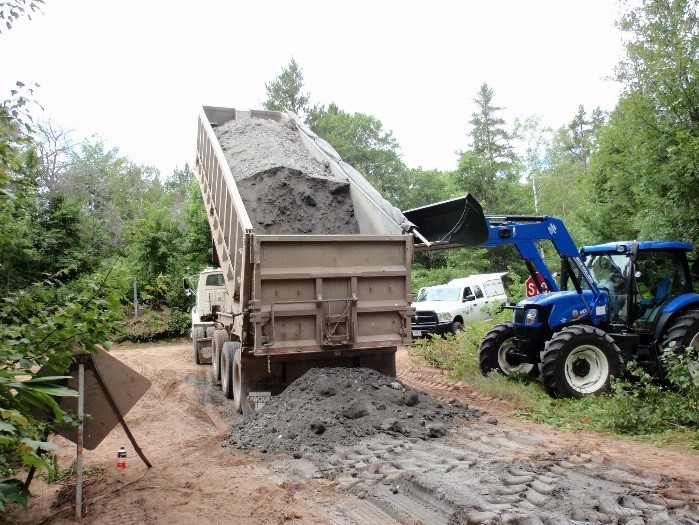 Ash delivered to unstable road. Source: U.S. Forestry Service
Back to top
About Local Aid Support Team
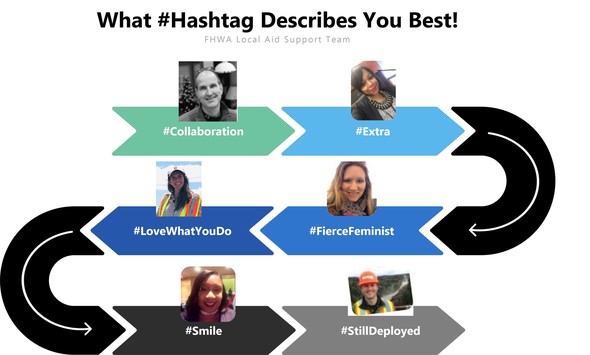 Source: FHWA Local Aid Support
Back to top
Bulletin Board

|
FHWA Local Aid Support is rebooting the Innovation Exchange Webinar series. No pre-registration is required. Subscribe to the Local Aid Support newsletter for updates on log-in information.
Here are the planned topics:
Deterring Beaver Technology
July 15, 2021
2 p.m.–3:30 p.m. ET
Composite Bridge Technology
August 19, 2021
2 p.m.–3:30 p.m. ET
EDC: Ultra-High Performance Concrete (UHPC)
September 16, 2021
2 p.m.–3:30 p.m. ET
Build a Better Mousetrap 2021 Winners
October 21, 2021
2 p.m.–3:30 p.m. ET
ADDITIONAL TRAINING WEBINARS
Value Capture Strategies: Transportation Reinvestment Zones—The Primer
July 14, 2021
1 p.m.–3 p.m. ET
Registration
Emerging Asphalt Emulsion Technologies
July 15, 2021
2 p.m.–3:30 p.m. ET
Registration
Value Capture Strategies: Developer Impact Fees—The Primer
August 4, 2021
1 p.m.–3 p.m. ET
Registration
Projection Selection for In-place Recycling
August 19, 2021
2 p.m.–3:30 p.m. ET
Registration
Value Capture Strategies: Special Assessment Districts—The Primer
August 25, 2021
1 p.m.–3 p.m. ET
Registration
Value Capture Strategies: Risk Assessment—The Primer
September 15, 2021
1 p.m.–3 p.m. ET
Registration
Slurry & Micro Surfacing Construction Best Practices, Part I
September 16, 2021
2 p.m.–3:30 p.m. ET
Registration
See your state LTAP for even more training options. https://www.fhwa.dot.gov/clas/ltap/
UPCOMING EVENTS
NLTAPA National LTAP and TTAP Association
Virtual Summer Conference
July 20–July 22
Register: https://cornell.zoom.us/webinar/register/WN_O5k3JPHMTIWF_xO9I-E-dw
APWA
American Public Works Association
Public Works Expo
PWX 2021: Stronger Together
St. Louis
August 29–September 1
https://www.apwa.net/PWX/Home/PWX/Home.aspx?hkey=a6723d4f-0994-46a2-9e70-e604c6ed886a
Roadway Management Conference (RMC)
October 6–8, 2021
Rehoboth Beach, DE
https://roadwaymanagementc.wixsite.com/home
|